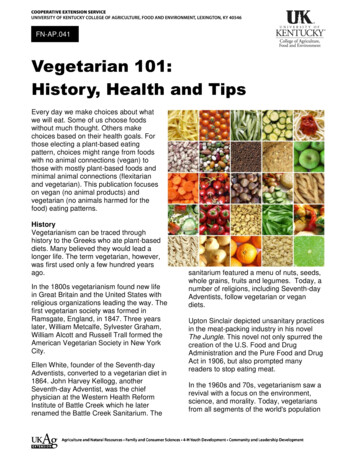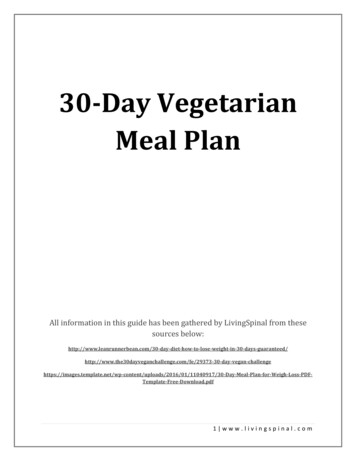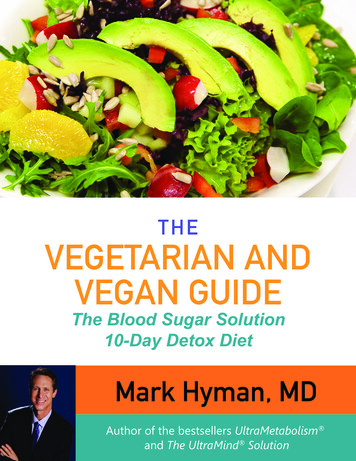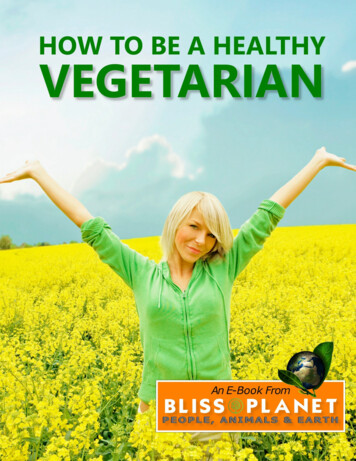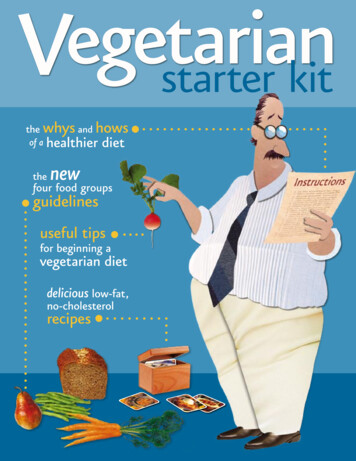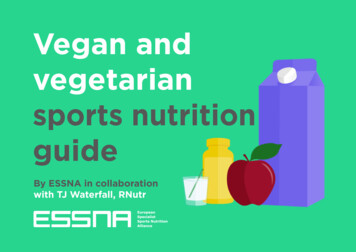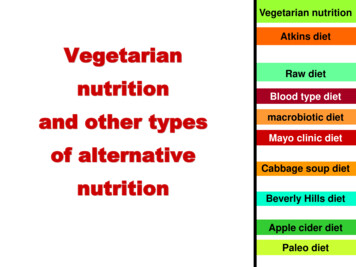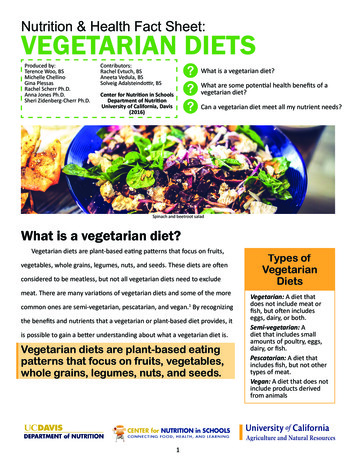
Transcription
Nutrition & Health Fact Sheet:VEGETARIAN DIETSProduced by:Terence Woo, BSMichelle ChellinoGina PlessasRachel Scherr Ph.D.Anna Jones Ph.D.Sheri Zidenberg-Cherr Ph.D.Contributors:Rachel Evtuch, BSAneeta Vedula, BSSolveig Adalsteindottir, BSWhat is a vegetarian diet?What are some potential health benefits of avegetarian diet?Center for Nutrition in SchoolsDepartment of NutritionUniversity of California, Davis(2016)Can a vegetarian diet meet all my nutrient needs?Spinach and beetroot saladWhat is a vegetarian diet?Vegetarian diets are plant-based eating patterns that focus on fruits,vegetables, whole grains, legumes, nuts, and seeds. These diets are oftenconsidered to be meatless, but not all vegetarian diets need to excludemeat. There are many variations of vegetarian diets and some of the morecommon ones are semi-vegetarian, pescatarian, and vegan. By recognizing1the benefits and nutrients that a vegetarian or plant-based diet provides, itis possible to gain a better understanding about what a vegetarian diet is.Vegetarian diets are plant-based eatingpatterns that focus on fruits, vegetables,whole grains, legumes, nuts, and seeds.1Types ofVegetarianDietsVegetarian: A diet thatdoes not include meat orfish, but often includeseggs, dairy, or both.Semi-vegetarian: Adiet that includes smallamounts of poultry, eggs,dairy, or fish.Pescatarian: A diet thatincludes fish, but not othertypes of meat.Vegan: A diet that does notinclude products derivedfrom animals
What are some potentialhealth benefits of avegetarian diet?5 Tips for PlanningHealthful VegetarianMeals.3Vegetarian diets have many potential health benefits.Research shows that vegetarians have a lower risk ofdeath from cardiovascular disease and certain types ofcancer.8 This may be because vegetarian diets often havemore fiber and lower saturated fat compared to diets withmeat.9 This is possible because vegetarian diets have morefruits, vegetables, whole grains, and legumes.The American Institute for Cancer Research, theAmerican Heart Association, and the National Heart, Lung,and Blood Institute all recommend consuming a diet highin fruits and vegetables.10, 11, 12Research shows that vegetarianshave lower risk of death fromcardiovascular disease andcertain types of cancer.9Penne pasta with tomato and rucolaBuild your meals around protein:Use sources that are naturally lowin fat such as: beans, lentils, andrice. Avoid overloading meals withhigh-fat cheeses to replace meat.Use calcium-fortified, soy-basedbeverages such as soy milk: Thesecan provide calcium in amountssimilar to milk, and also be lowerin saturated fat.Turn meat-based foodsvegetarian: Dishes that are madeto contain meat can be adaptedto be vegetarian. This method isgreat for eating more vegetables.Try ethnic cuisines: Indian, MiddleEastern, Hispanic, and Asian foodshave many plant-based dishes thathave plenty of protein from beans,nuts, and high-protein grainsChoose complementary foods:Complementary foods such asbeans and rice, tofu and tempeh,or even eggs and dairy allow theright combinations of essentialprotein to be included in the diet.Cooked broccoli soup2
Can a vegetarian dietmeet all my nutrientneeds?Like all diets, a vegetarian diet should be nutritionallybalanced through variety and moderation of foods. Table1 provides recommendations from the 2015-2020 DietaryGuidelines for Americans following a 2000-calorie diet foradults on a vegetarian diet.7Meat-based diets and plant-based diets providedifferent amounts of essential nutrients. Nutrients thatare common in meat-based diets may be low-in plantSalad table for lunch or dinnerWhat is Fortification?based diets and vice versa. Vegetarians should obtain thenutrients that would normally be easy to get from animalfoods from different sources.2The stricter a plant-based vegetarian diet is, the morethat specific nutrients must be found from other sources.Vegetarians should obtain thenutrients that would normally beeasy to get from animal foodsfrom different sources.Fortifying foods withnutrients means thatmore is added to theoriginal amount. Forvegetarians, fortifiedfoods are importantbecause excludingcertain food groups may make it difficultto obtain certain nutrients. For example,vegetarians who exclude dairy from their dietsshould get calcium from a combination of foodsthat are calcium fortified, such as orange juiceor cereal. In some cases, fortified foods are theonly option for nutrients such as Vitamin B12which may be inactive in plants foods. Knowwhich nutrients you may need a fortifiedsource of, and always remember to check foodlabels to meet your nutritional requirements.What Are Some Nutrients I Need and Where Can I Get Them?Protein: Beans, nuts, quinoa, tofu and other soybased protein foods.3, 4, 5, 6Vitamin B12: Vitamin supplements, fortifiedfoods (commercial breakfast cereals, soybeverages, nutritional yeast)Iron: Dried or fortified beans and cereals,spinach, chard, dried fruitVitamin D: Fortified dairy products, egg yolks,liver, and fatty fish. Also consider breakfastcereals, soymilk, and supplementation.Calcium: Collard greens, spinach, almonds,soybeans. Calcium-fortified orange juice,fortified cereal, fortified soymilk, and tofuOmega-3 Fatty Acids: Fish, walnuts, and groundflaxseeds.Zinc: Whole grains, nuts, legumes3
Table 1: Vegetarian Food Guide for Adults Following a 2000Calorie Diet.7, 13Food GroupVegetablesFruitsGrainsDairyProtein FoodsOilsDailyAmounts2 1/2 cups2 cups6 1/2 oz-eq†3 cups3 1/2 oz-eq6 tspExamples of Serving SizeEquivalentsExamples of Calcium-richNon-dariy Food Sources*1 cup equivalent of vegetables: 1 cup raw or cooked cress, 1 cup raw or cooked vegetablesrhubarb, broccoli 2 cups raw leafy greens 1 cup calcium-fortified vegetable 1 cup calcium-fortified vegetablejuicejuice1 cup equivalent of fruit: 1 medium fruit ½ cup diced or cooked fruit ¼ cup dried fruit ½ cup calcium-fortified fruitjuice 5 dried figs1 oz equivalent of grains: 1 slice bread 1 cup calcium-fortified ready-toeat cereal ½ cup cooked grain, pasta, orcereal ½ cup brown or white rice 1/2 cup calcium-fortified fruit juice 5 dried figs1 cup equivalent of milk: 1 cup milk 1 cup yogurt 1 ½ oz natural cheese 2 oz processed cheese 1 cup calcium-fortified soymilk 1 cup calcium-fortified soymilk1 oz equivalent of protein foods: ¼ cup cooked beans, peas,lentils ¼ cup tofu 1 egg 1 Tbsp nut or seed butter 1 oz meat substitute ½ oz nuts 1/4 cup cooked white beans, redbeans, chickpeas 1/4 cup tofu 1/2 oz almonds, hazlenuts 1 cup calcium-fortified ready-toeat cereal1 tsp equivalent of oils: 1 tsp. soft margarine,mayonnaise, or oilNote: The information in this table is adapted from Appendix 5 – Healthy Vegetarian Eating Pattern of the 2015-2020 USDA Dietary Guidelines for Americans*Foods in this column are in 1 serving size equivalents. For those following vegan or ovo-vegetarian diets, the dairy group, except for soymilk, will be omitted.†Ounce Equivalents (oz eq): Cup and ounce equivalents identify the amounts of foods from each food group with similar nutritional content4
References:1.2.3.4.5.6.7.8.9.10.11.12.13.Dinu M, et al. Vegetarian, vegan diets and multiple health outcomes: a systematic review with meta-analysis ofobservational studies. Crit Rev Food Sci Nutr. 2016 Feb 6:0. doi: 10.1080/10408398.2016.1138447Mangels, R. “Protein in the vegan diet.” Simply Vegan. 5th Edition. The Vegetarian Resource Group, Nutrition. (1999).Karabudak E, et al. A comparison of some of the cardiovascular risk factors in vegetarian and omnivorous Turkish females.J Hum Nutr Diet. 2008 Feb;21(1):13-22. doi: 10.1111/j.1365-277X.2007.00831.x.National Institute of Health: Office of Dietary Supplements. Vitamin B12 Dietary Supplement Fact Sheet. hProfessional/. Accessed Aug. 13, 2016Holick MF, et al. Vitamin D2 is as effective as vitamin D3 in maintaining circulating concentrations of 25-hydroxyvitamin D.J Clin Endocrinol Metab. 2008 Mar;93(3):677-81. Epub 2007 Dec 18.Lane K, et al. Bioavailability and potential uses of vegetarian sources of omega-3 fatty acids: a review of the literature. CritRev Food Sci Nutr. 2014;54(5):572-9. doi: 10.1080/10408398.2011.596292U.S. Department of Health and Human Services and U.S. Department of Agriculture. Appendix 5, 2015 – 2020 DietaryGuidelines for Americans. 8th Edition. December 2015. es/appendix-5/. Accessed Aug. 13, 2016.Chang-Claude J, et. al. Lifestyle determinants and mortality in German vegetarians and health-conscious persons: Resultsof a 21-year follow-up. Cancer Epidemiol Biomarkers Prev. 2005 Apr;14(4):963-8.U.S. Department of Health and Human Services and U.S. Department of Agriculture. 2015 – 2020 Dietary Guidelines forAmericans. 8th Edition. December 2015. s/. Accessed Aug. 13, 2016.American Heart Association Nutrition Committee, et al. Diet and lifestyle recommendations revision 2006: A scientificstatement from the American Heart Association Nutrition Committee. Circulation. 2006 Jul 4;114(1):82-96.Chobanian AV, et al. Seventh report of the Joint National Committee on Prevention, Detection, Evaluation, and Treatment ofHigh Blood Pressure. Hypertension. 2003 Dec;42(6):1206-52.American Dietetic Association and Dietitians of Canada. Position of the American Dietetic Association and Dietitians ofCanada: Vegetarian diets. J Am Diet Assoc. 2003 Jun;103(6):748-65.“Calcium Content of Common Foods.” International Osteoporosis Foundation. International Osteoporosis Foundation, n.d.Web. 03 Oct. 2016.The University of California prohibits discrimination or harassment of any person on the basis of race, color, national origin,religion, sex, gender identity, pregnancy (including childbirth, and medical conditions related to pregnancy or childbirth),physical or mental disability, medical condition (cancer-related or genetic characteristics), ancestry, marital status, age,sexual orientation, citizenship, or service in the uniformed services (as defined by the Uniformed Services Employment andReemployment Rights Act of 1994: service in the uniformed services includes membership, application for membership,performance of service, application for service, or obligation for service in the uniformed services) in any of its programs oractivities.University policy also prohibits reprisal or retaliation against any person in any of its programs or activities for making acomplaint of discrimination or sexual harassment or for using or participating in the investigation or resolution process of anysuch complaint.University policy is intended to be consistent with the provisions of applicable State and Federal laws.Inquiries regarding the University’s nondiscrimination policies may be directed to the Affirmative Action/Equal OpportunityDirector, University of California, Agriculture and Natural Resources, 1111 Franklin Street, 6th Floor, Oakland, CA 94607, (510)987-0096.Copyright The Regents of the University of California, Davis campus, 2016. All rights reserved. Inquiries regarding thispublication may be directed to cns@ucdavis.edu. The information provided in this publication is intended for generalconsumer understanding, and is not intended to be used for medical diagnosis or treatment, or to substitute for professionalmedical advice.All pictures are used under the Creative Commons Zero (CC0) license.5
Simply Vegan. 5th Edition. The Vegetarian Resource Group, Nutrition. (1999). 3. Karabudak E, et al. A comparison of some of the cardiovascular risk factors in vegetarian and omnivorous Turkish females. J Hum Nutr Diet. 2008 Feb;21(1):13-22. doi: 10.1111/j.1365-277X.2007.00831.x. 4. National Institute o

